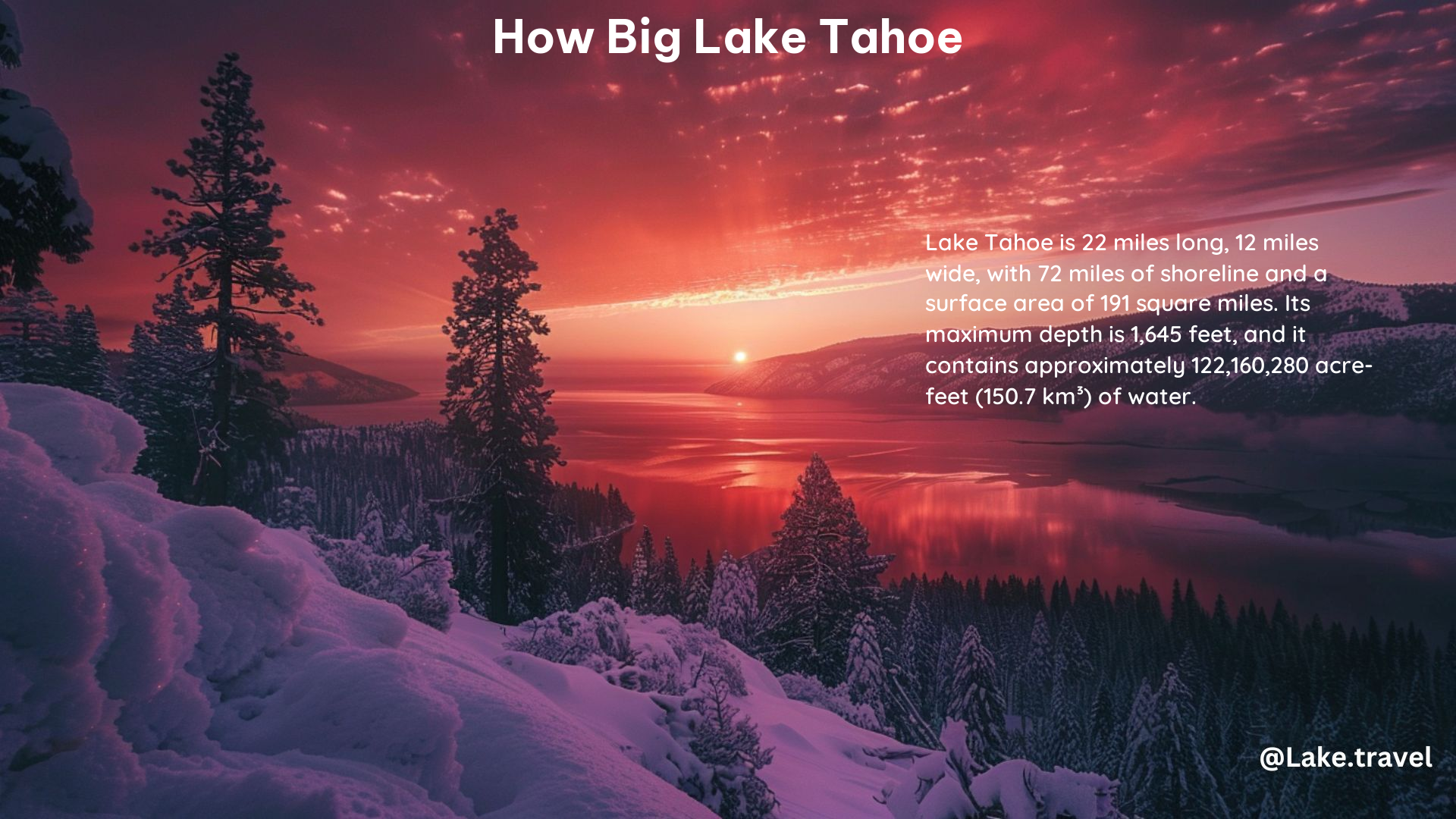Lake Tahoe is a significant freshwater lake located in the Sierra Nevada mountains, straddling the border between California and Nevada in the Western United States. It is a popular destination for outdoor recreation and tourism, offering a range of activities such as skiing, boating, and hiking.
The Dimensions of Lake Tahoe
Here are the key details about the size of Lake Tahoe:
| Measurement | Dimension |
|---|---|
| Length | Approximately 22 miles (35 kilometers) |
| Width | Approximately 12 miles (19 kilometers) |
| Surface Area | 191 square miles (490 square kilometers) |
| Shoreline | 72 miles (116 kilometers) |
| Maximum Depth | 1,645 feet (501 meters) |
| Volume | Approximately 122,160,280 acre-feet (150.7 cubic kilometers) |
As you can see, Lake Tahoe is a massive body of water, with a surface area of 191 square miles and a maximum depth of over 1,600 feet. Its sheer size and depth make it a truly impressive natural wonder.
The Depth of Lake Tahoe

One of the most remarkable features of Lake Tahoe is its depth. At a maximum depth of 1,645 feet (501 meters), it is the second-deepest lake in the United States, after Crater Lake in Oregon.
This depth is a result of the lake’s geological history. Lake Tahoe was formed by tectonic activity and glacial erosion, which carved out a deep basin in the Sierra Nevada mountains. The lake’s depth is a testament to the power of these natural forces.
The depth of Lake Tahoe also has important implications for its ecology and water quality. The deep, cold waters of the lake help to maintain a stable temperature and support a diverse ecosystem of aquatic life.
The Volume of Lake Tahoe
In addition to its impressive depth, Lake Tahoe is also one of the largest lakes in the United States by volume. The lake contains approximately 122,160,280 acre-feet (150.7 cubic kilometers) of water.
This massive volume of water is a result of the lake’s large surface area and depth. The combination of these factors makes Lake Tahoe a truly remarkable body of water.
The volume of Lake Tahoe also has important implications for its use and management. The lake is a critical source of water for the surrounding region, and its large volume helps to ensure a reliable supply of water for both human and ecological needs.
The Shoreline of Lake Tahoe
Another notable aspect of Lake Tahoe is its extensive shoreline. The lake has a total shoreline of 72 miles (116 kilometers), which is a significant distance.
The shoreline of Lake Tahoe is characterized by a variety of landscapes, including rocky cliffs, sandy beaches, and forested areas. This diversity of shoreline environments contributes to the lake’s natural beauty and appeal as a recreational destination.
The shoreline of Lake Tahoe is also an important habitat for a variety of wildlife, including birds, mammals, and aquatic species. The protection and preservation of the lake’s shoreline is an important priority for conservation efforts in the region.
The Significance of Lake Tahoe’s Size
The sheer size of Lake Tahoe makes it a truly remarkable natural feature. Its large surface area, depth, and volume contribute to its importance as a natural resource and recreational destination.
The size of Lake Tahoe also has important implications for its ecology and management. The lake’s depth and volume help to maintain a stable temperature and support a diverse ecosystem of aquatic life. The lake’s large shoreline provides important habitat for a variety of wildlife.
In addition, the size of Lake Tahoe makes it a critical source of water for the surrounding region. The lake’s large volume helps to ensure a reliable supply of water for both human and ecological needs.
Overall, the size of Lake Tahoe is a testament to the power and beauty of the natural world. Its impressive dimensions make it a truly remarkable natural wonder, and a must-visit destination for anyone interested in outdoor recreation and the great outdoors.
Conclusion
Lake Tahoe is a truly remarkable body of water, with impressive dimensions that make it a unique and significant natural feature. Its large surface area, depth, and volume contribute to its importance as a natural resource and recreational destination.
Whether you’re interested in outdoor activities like skiing, boating, and hiking, or simply appreciating the natural beauty of the lake, Lake Tahoe is a must-visit destination. Its size and scale are truly awe-inspiring, and a testament to the power and wonder of the natural world.
References:
– Lake Tahoe Basin Management Unit
– Tahoe Regional Planning Agency
– National Park Service – Lake Tahoe
